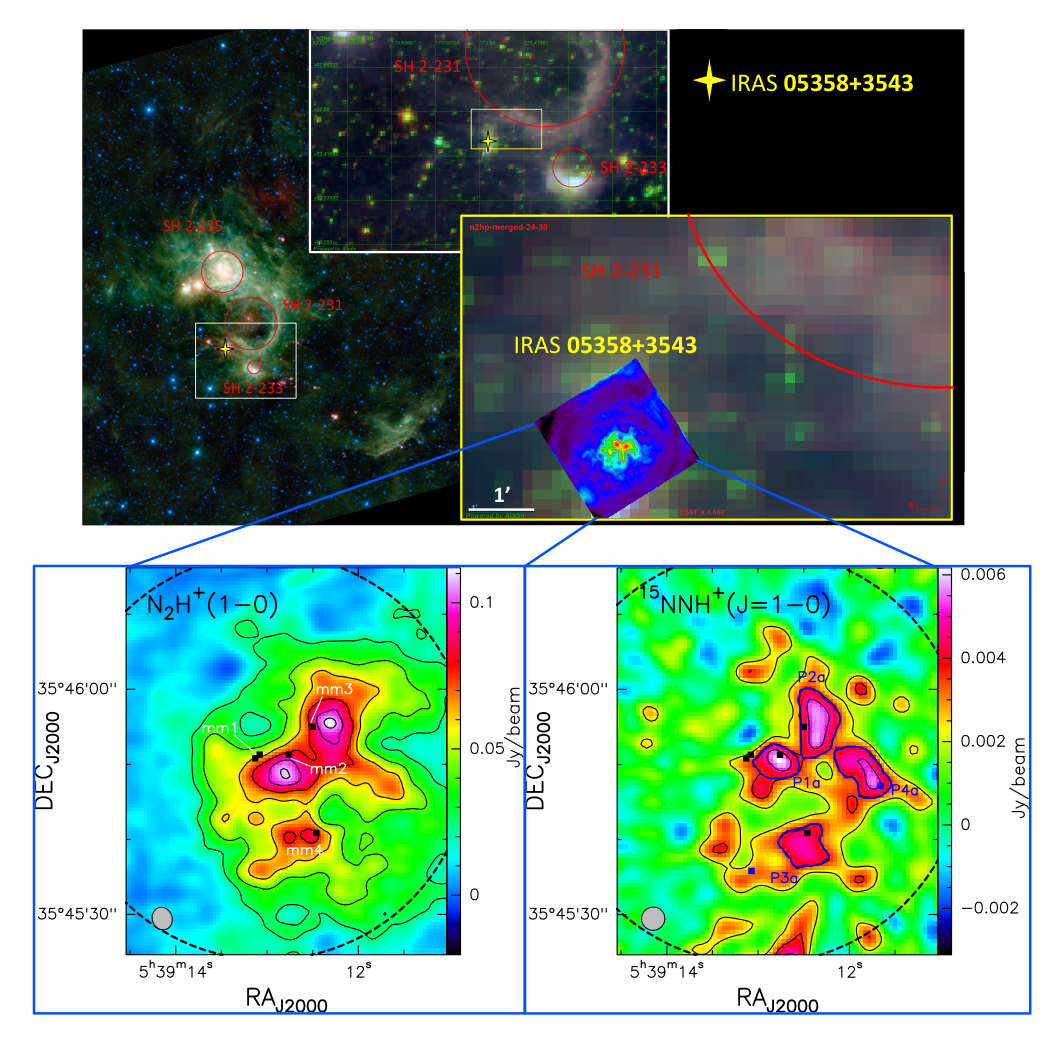Hints on the Solar system formation from the isotopic composition of a distant star-forming region
First interferometric study of enhanced N-fractionation in N2H+: the high-mass star-forming region IRAS 05358+3543
The study of the chemical evolution of our Solar System is a powerful tool to understand how it was formed. In particular, some isotopic ratios, such as D/H and 14N/15N, can be used to understand whether the molecules in pristine Solar System minor bodies, like comets or asteroids, are inherited from the cold proto-Solar nebula (PSN) or if they are the result of chemical processing within the Solar protoplanetary disc.
The 14N/15N ratio measured for the PSN is about 440, two times larger than that measured in the terrestrial atmosphere, about 272. The PSN value is also larger than that measured in comets and in carbonaceous chondrites (100-150). This suggests a local chemical enrichment of 15N during the formation process of the Sun. However, the relation between the 15N-enrichments in pristine Solar System material and the natal clump is still uncertain. Since our Sun was likely born in a rich cluster containing massive stars, i.e. stars with mass > 8 times that of our Sun, which likely exploded as supernovae affecting the dynamics and the chemistry of the PSN, studying the 14N/15N ratio towards intermediate- and high-mass star forming regions is of particular interest for the astrochemical community.
In this context, a team of astronomers led by Laura Colzi – a PhD student at the University of Florence - and including also Francesco Fontani from INAF-Astrophysical Observatory of Arcetri, studied the 14N/15N isotopic ratio towards the high-mass star-forming protocluster IRAS 05358+3543. In this work they have obtained the first interferometric maps of 14N/15N ratio combining single-dish (IRAM 30m radiotelescope) and interferometric NOEMA observations of the 15N isotopologues of N2H+.

Fig.1: Upper panel: WISE observations of the Auriga molecular cloud complex and several zooms towards the high-mass star-forming protocluster IRAS 05358+3543 (NOEMA map in lower panels). Red circles represent the HII regions. WISE colors: blue and cyan represent 3.4- and 4.6-micron wavelengths, which is primarily light emitted from hot stars. Green and red represent 12- and 22- micron wavelengths, which is mostly light from warm dust. Lower panels: NOEMA interferometric maps of N2H+(1-0), on the left, and 15NNH+(1-0), on the right. The blue polygons on the right panels are those from which they have derived 14N/15N isotopic ratios. Note that for N15NH+(1-0) they found a similar map.
The source is located at a distance of 1.8 kpc in the Auriga molecular cloud complex, in the Perseus spiral arm of the Milky Way, and has a bolometric luminosity of 6300 LSUN. The source is part of a complex group of HII regions where SH 2-235 is the brightest one (upper panel of Fig. 1). IRAS 05358+3543 is resolved in four continuum sources: mm1, a young massive protostar (∼5 MSUN) where the central source has already started hydrogen burning, and mm2, mm3 and mm4 less evolved than mm1. Since these sources belongs to different evolutionary stages, they present different densities and temperatures.
We find 14N/15N ratios that span from ∼100 up to ∼200 towards the denser cores (lower panel of Fig. 1), and these values are lower or equal than those derived in the more diffuse regions of the protocluster (14N/15N>200). These results provide the very first indication that N-fractionation changes across the studied region, depending on densities and temperatures. This means that this phenomenon is regulated by local environmental effects and which can be a possible explanation for the anomalous 15N enrichment in pristine Solar system bodies.
Thanks to these results, the Authors are now able to make a first step towards the understanding of N-fractionation with the recent chemical models that take into account all possible processes which can affect fractionation of some important molecules, like N2.
Publication:
First interferometric study of enhanced N-fractionation in N2H+: the high-mass star-forming region IRAS 05358+3543, L. Colzi, F. Fontani, P. Caselli, S. Leurini, L. Bizzocchi, G. Quaia, 2019, article accepted in Monthly Notices of the Royal Astronomical Society, in press, arXiv:1903.06567, https://arxiv.org/abs/1903.06567
Contact:
Laura Colzi PhD student
Università degli Studi di Firenze, Florence, Italy and INAF-Osservatorio Astrofisico di Arcetri, Florence, Italy
Mail: Questo indirizzo email è protetto dagli spambots. È necessario abilitare JavaScript per vederlo.



